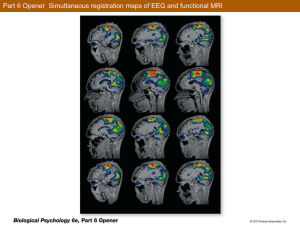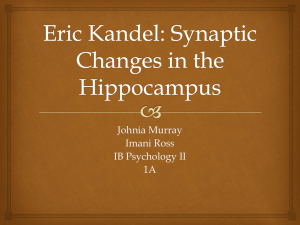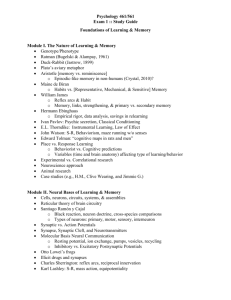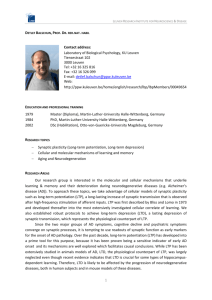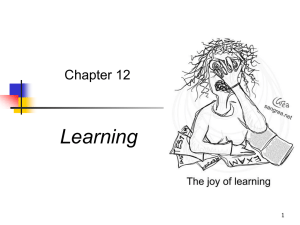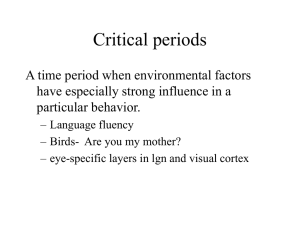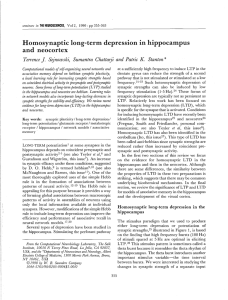MCDB 4777/5777 Molecular Neurobiology Lecture 17 Mechanisms of Synaptic Plasticity and Learning
advertisement
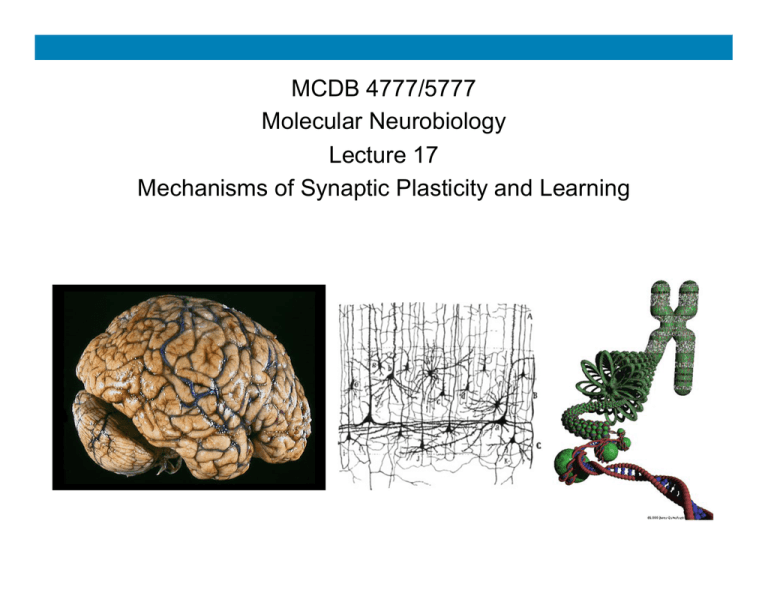
MCDB 4777/5777 Molecular Neurobiology Lecture 17 Mechanisms of Synaptic Plasticity and Learning Learning Goals for Lecture 17 2.4 Understand mechanisms by which patterns of neuronal activity can lead to synaptic plasticity a. Distinguish between mechanisms that increase and decrease synaptic strength (habituation, sensitization, LTP, LTD). b. Relate intracellular signal transduction mechanisms to modification of neuronal excitability properties. Goals for today… The neuromuscular junction- a synapse that can change with prior activity Aplysia and a primitive form of learning- habituation and sensitization The hippocampus and its requirement for spatial learning and memory Hippocampal circuitry and long-term potentiation of synaptic strengthdefinition Requirements for LTP- association and timing Figure 8.2 Short-term plasticity at the neuromuscular synapse (Part 1) 24.1 Short-term sensitization of the Aplysia gill withdrawal reflex. (Part 1) 24.1 Short-term sensitization of the Aplysia gill withdrawal reflex. (Part 2) Lecture 17 What mechanism would you predict causes this serotonin-mediated short-term sensitization of the Aplysia gill withdrawal circuit, in the time frame observed? A. a change in gene transcription B. a change in mRNA translation C. a change in posttranslational modification D. a change in ion concentration gradients 24.2 Synaptic mechanisms underlying short-term sensitization. (Part 1) 24.2 Synaptic mechanisms underlying short-term sensitization. (Part 2) Habituation- due to synaptic depression- fewer vesicles for release Behavioral Sensitization- serotonin from modulatory interneuron enhances transmitter releasesynaptic facilitation Lecture 17 What kind of posttranslational modification would most likely cause the effect seen here after shocking the tail in Aplysia? A. phosphorylation of Ca2+ channels, reducing the chance they will open during a depolarization B. phosphorylation of K+ channels, reducing the chance they will open during a depolarization C. phosphorylation of metabotropic serotonin receptors, reducing their activation of G-protein D. Transcription, translation, and insertion of additional voltage-gated calcium channels Additional InfoAll synapses shown are excitatory Modulatory interneuron- uses serotonin As an excitatory transmitter 24.3 Mechanism of presynaptic enhancement underlying behavioral sensitization. (Part 1) Mechanisms of short-term Sensitization- serotonin from modulatory interneuron enhances transmitter release Lecture 17 What mechanism would you predict causes this serotonin-mediated long-term sensitization of the Aplysia gill withdrawal circuit, in the time frame observed? A. a change in gene transcription B. a change in mRNA translation C. a change in posttranslational modification D. a change in ion concentration gradients 24.3 Mechanism of presynaptic enhancement underlying behavioral sensitization. (Part 2) Long-term Sensitization- increased degradation of PKA regulatory subunit; PKA constitutive Also- C/EBP causes creation of additional synapses Box A Genetics of Learning and Memory in the Fruit Fly Dunce- cAMP phosphodiesterase Rutabaga- adenylyl cyclase Amnesiac-peptide transmitter stimulating adenylyl cyclase Manipulation of CREB also interferes w/ learning & memory in flies The rodent hippocampus 30.7 Spatial learning and memory in rodents depends on the hippocampus. (Part 1) Testing spatial learning and memory in rodents 30.7 Spatial learning and memory in rodents depends on the hippocampus. (Part 2) 24.5 Diagram of a section through the rodent hippocampus. Lecture 17, CQ 1 What happens to pathway 1 after high frequency stimulation? A. there is a higher frequency of action potentials B. More pathways are activated, including pathway 2 C. There must be more transmitter released or a more responsive postsynaptic membrane D. The Schaeffer collaterals increase in number E. All of the above Figure 8.7 Long-term potentiation of Schaffer collateral-CA1 synapses Figure 8.7 Long-term potentiation of Schaffer collateral-CA1 synapses (Part 1) Figure 8.7 Long-term potentiation of Schaffer collateral-CA1 synapses (Part 2) Figure 8.7 Long-term potentiation of Schaffer collateral-CA1 synapses (Part 3) 24.7 Pairing presynaptic and postsynaptic activity causes LTP. (Part 1) +depolarize! 24.7 Pairing presynaptic and postsynaptic activity causes LTP. (Part 2) LTP is state-dependentpairing of a weak stimulus (that wouldn t cause LTP) w/ depolarization (w/in ~100ms) leads to LTP


